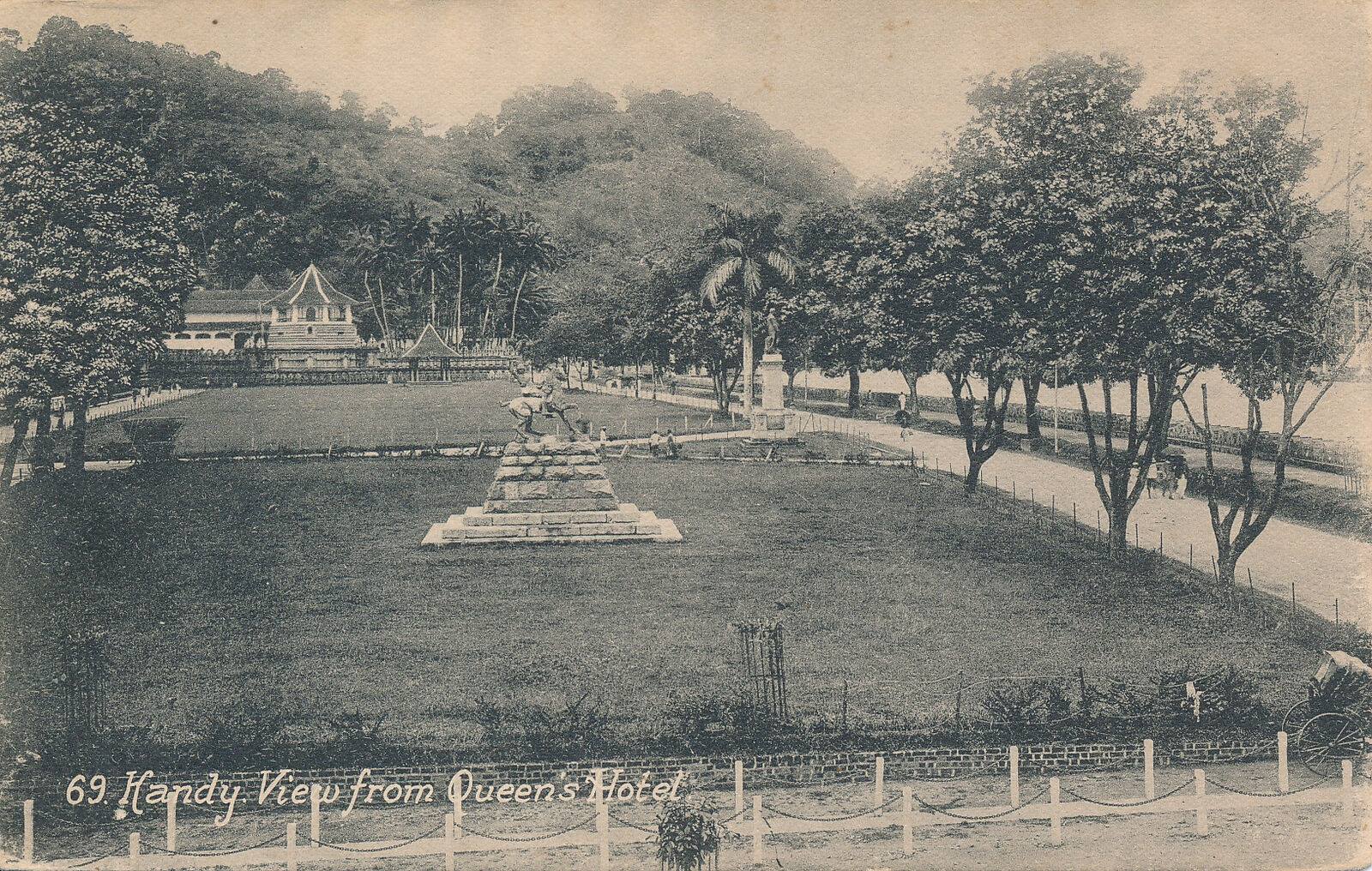The Cave-Temples of Dambulla
හවස් යාමයේ දඹුලු විහාරය දකින්න අපි දඹුලු ගල උඩට නැග්ගා. විශාල පර්වතයක්. අඩි 500ක් 600ක් විතර උසයි. කුරුණෑගල තියන ගල වගේ. අඩක් දුර නගිනවිට පළලට පැතිරුණ ගැටියක් දකින්න ලැබෙනවා. යාර 100ක් දිගයි. එතැනට අවට කඳු මිටියාවත් වල කදිම දර්ශනයක් පෙනෙනවා. මේ ගැටියත් ඊට උඩින් ඉස්සරහට නෙරා තියන ගල් ස්ථරයත් අතර තියන අවකාශයේ රළු බදාම තාප්පයකින් ආවරණය කළ විහාර මන්දිර පහක් එක පෙළට දකින්න පුළුවන්.
 |
| Outside of Rock Temple Dambulla and the Buddhist Priests photographed by Skeen & Co. [Image Courtesy: http://www.imagesofceylon.com ] |
දඹුල්ලේ ලෙන් ආරාම
ගුහා දොර පසු කරගෙන විශාල ගුහාව ඇතුළට ගියාම ග්රාම්ය ලෙස නෙළු, පිළිම වහන්සේලා සෑහෙන ප්රමාණයක් දකින්න පුළුවන්. විහාර කුටීරයන්ගෙන් විශාලතම එක අඩි 150ක් දිගයි, අඩි 40ක් ඇතුළට විහිදිලා, අඩි 23ක් ඉදිරියෙන් උසයි. බොහොම අඳුරු අවකාශයක්. මේ අන්ධකාරේ, නිර්වාණය මූර්තිමත් කෙරෙන, දුර්වර්ණ සිනහවකින් හිඳගෙන සිටින බුදුරදුන්ගේ මහා පරිමාණ පිළිරූ 50ක් වගේ තියනවා.
 |
| Interior of Cave Temple Dambulla with Buddhist Statues and Rock Roof photographed by Skeen & Co. [Image Courtesy: www.imagesofceylon.com ] |
 |
| Interior of Cave Temple Dambulla with Buddhist Statues and Rock Roof (ca. 1880) photographed by Skeen & Co. [Image Courtesy: www.lankapura.com ] |
ගල් ලෙන් පියස්සේ සහ අයිනේ පැති වල පවා බුද්ධ චරිතයේ සිදුවීම් බොහොම ගොරොක් විදිහට බිතු සිතුවම් කර තිබුණා. ඒ අතර හින්දු දේව රූපයනුත් දකින්න ලැබුණා.
 |
| Interior of Cave Temple Dambulla with Buddhist Statues and Rock Roof photographed by Skeen & Co. [Image Courtesy: www.imagesofceylon.com ] |
මේ අතරේ අවුරුදු දහස් ගණනක පුස් ගඳ, වැඩි පිරිසිදු කමක් නැති පැවිද්දෝ, දැල්වෙන පොල්තෙල් පහන්, පරවුණු මල් සහ යල් පැනපු සාම්බ්රානි සුවඳ, අපට සෑහෙන අසහනකාරි බවක් ගෙන දුන්නා. එතනින් නැවතත් එළියට ආවම දැනුණේ සෑහෙන ලොකු සහනයක්. ඩී වොස් කිව්වේ උත්සව කාලෙට මෙහෙ දකින්න ලැබෙන දර්ශනය බොහොම සිත් ඇදගන්නවා කියලයි. ඒ කාලෙට අනේක සංඛ්යාත වන්දනාකරුවන් මෙතනට එක් රොක් වෙලා ආලෝකයෙන්, පුෂ්පයන්ගෙන් සහ මුදලෙන් සෑම බුදු රුවක් ඉදිරියේම ඇති ඵලක මත පුද පූජා පවත්වනවාලු. ඇතුළතින් නැගෙන බෙරවාදනත්, දැල්වෙන දිදුලන ආලෝකයත්, සැදැහවතුන්ගේ ගාථා සූත්ර සජ්ජායනාත් එක්ක පිටතින් පුර සඳෙන් වෑහී ගල මත පතිත වෙන ආලෝකය බොහොම චමත්කාරයිලු.

මේ ගල් පර්වතයට උරුමකම් කී වඳුරන් සිය ගණනක් මේ ගැටිය මත, මෙහි සංඝයා හිමිවරුන්ගෙන් ආහාර සංග්රහ ලබා ගන්නවා.
 |
| Dambulla Caves Sectional Views |
ලංකාවේ ප්රධාන වශයෙන් සිටින්නේ බෞද්ධයෝ. මේ දූපතේ කඳුකර පළාත් පුරාවටම, මීට වඩා කුඩා මේ වගේ ගල් විහාර රාශියක් විසිරී පැතිරී තියනවා. සමහරක්වා නිකම්ම සිද්ධස්ථාන. බුදුන්ගේ එක් හිඳි පිළිමයක් හෝ සැතපුණු පිළිමයක් තියන ඒවා. මේ ගල් විහාර ලෙන් සාමාන්යයෙන් තනන්නේ වන මැද ගල් පර්වතයක ඉස්සරහට නෙරා තියන අධික බෑවුමක. කතාවට කියවෙන විදිහට නම් මේ ගුහා ලෙන් වල ඉස්සර කාලයේ යෝගීවරු හෝ ඉසිවර තාපසවරු වාසය කරලා තියනවා. ඒවායේ විහාර හදලා තියෙන්නේ ඔවුන්ව සිහි වෙන්නලු.
 |
| Outside of Cave Temple Dambulla photographed by Skeen & Co. [Image Courtesy: Threeblindmen Photography Archive – Ceylon Memory Project] |
“ආදම්ගේ ශිඛරය මතින් එලිෆන්ටා ගුහා වෙත – ලක්දිව සහ ඉන්දියාවේ රූප සටහන්” : එඩ්වඩ් කාපෙන්ටර්
පස්වන පරිච්ඡේදය : බ්රිතාන්යය නීති පද්ධතිය සහ බෞද්ධ සිද්ධස්ථාන.
From Adam’s Peak To Elephanta : Sketches in Ceylon and India by Edward Carpenter
CHAPTER V: BRITISH LAW-COURTS AND BUDDHIST TEMPLES.
In the afternoon we went up the rock to see the temples. A great rock, 500 or 6od feet high, similar to that at Kurunegala. Half-way up stretches a broad ledge, 100 yards long, commanding a fine view over hill and dale, and between this led^e and an overhanging layer of rock above are niched five temples all in a row. No facade to speak of, mere stucco walling, but within you pass into large caverns full of rude statues. The largest of the temples is 150 feet long, 40 deep, and 23 high in front—a great dark space with perhaps fifty colossal images of Buddha sitting round in the gloom with their sickly smile of Nirvana, and one huge figure, 30 or 40 feet long, lying down In illumined sleep ; all crudely done, and painted bright yellows and reds, yet rather impressive. The sides too and roof of the cavern are frescoed in the same crude manner with stories from the life of Buddha, and with figures of the Hindu gods. Withal, a fusty smell, a thousand years old, of priests none too clean, of flaring oil-lamps, of withered flowers and stale incense, oppressed us horribly, and it was the greatest relief to get out again into the open. Devos says the scene is very striking at the great festivals, when multitudinous pilgrims assemble and offer their lights and their flowers and their money, on benches each before the figure they affect. Tomtoms beat, worshipers recite their prayers, lights twinkle, and outside the light of the full moon pours down upon the rock. Monkeys native to the rock are fed on this ledge in hundreds by the priests.
Ceylon is of course mainly Buddhist, and all over the hilly part of the island rock-temples of this sort, though smaller, are scattered—some mere shrines with a single seated or recumbent image of Buddha. They are commonly built among the woods, under some overhanging brow of rock, and the story generally runs that the cavern had in earlier times been occupied by some hermit-saint, or yogi, and that the temple was built in remembrance of him.
ලක්දිව ගමන් සටහන් පිටු අංක: 39




Comments
Post a Comment